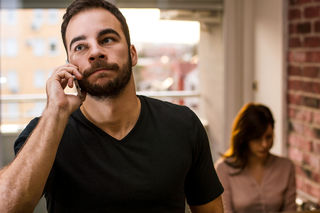Empathy
4 Ways to Be Assertive Without Alienating Others
Speak up for yourself with a blend of assertion and empathy.
Posted March 15, 2018 Reviewed by Devon Frye

Let’s face it: It can be hard to say no.
When you want to say no to a request, it sets into motion two conflicting desires. On the one hand, you want to protect your time, your body, and your self-respect; on the other hand, you want to connect with others, please them, and fit in with the group.* We all worry: “What if he takes offense?” “What if she goes ballistic?” “What if he decides not to help me out in the future?”
With many people, you might want to say a brief no and get on with it, regardless of creating a few hurt feelings or a little resentment.* But if you are communicating with a significant other, a colleague, a friend, or a relative, it’s a different story. You want to nourish your relationship with this person, so you may want to use a bit more tact, diplomacy, or warmth when you refuse a request or speak up about a nettlesome issue.
Is there a way to be assertive without running so much risk of alienating people who are important to you? Yes. You can use “empathic assertions."
You might want a quick overview of assertive behavior first. “Assertiveness” is usually defined as "direct, honest, and appropriate ways of standing up for your rights while respecting the rights of others.” By contrast, non-assertive behavior involves not speaking up and/or allowing your rights to be violated. Aggressive behavior is bullying behavior: It violates the self-respect and/or rights of other people. (For more, see here and here.)
Many people confuse assertion and aggression. While an assertive statement could be short and even brusque (sometimes called a “basic assertion”), there is no name-calling, blaming, shaming, or similar tactics that fall into the aggressive category. A simple "No," or "No, thanks," is a perfectly good basic assertion.
Empathic assertions come in when you want to go above and beyond a basic assertive response. "Empathy," the ability to understand other people by imagining how they might feel or think in a given situation, adds some heart to assertiveness. We’ll check out four types in the rest of this blog: basic empathic assertions, the “positive no,” the “empathy prompt,” and the “soft start-up.”
1. Basic Empathic Assertions
A short empathic assertion involves a simple two-part process. First, briefly acknowledge the other person’s point of view by conveying some appreciation for his or her situation, feelings, wants, or beliefs. (You don’t have to agree with them.) Second, state your own situation, wants, feelings, or beliefs.
Examples of brief empathic assertions include:
- “I know that it's important to you, but I don’t want to do that.”
- “I can see that this isn’t a good time to talk, so I’d like to set up a time when we can.”
- “I know it’s hard to say exactly how much the repair will cost, but I’d like a ballpark estimate.”
- “I’m sorry, but I already have too much on my plate.”
Empathic assertions run less risk of the other person feeling offended by your request or turn-down. Moreover, people are more likely to listen to your wants and needs when they have been acknowledged first. You yourself might feel more comfortable speaking out knowing that you are also signaling to the other person that you care about them.
The problem: A short empathic assertion is so brief that it can come across as chilly, unfeeling, or formulaic. Fortunately, other types of empathic assertions are more effective in fostering closeness, respect, and warmth with the other person.
Below I describe three creative and kind techniques that extend the idea of an empathic assertion. These techniques take into account your need to protect and preserve a valued relationship, while making sure that your own needs are met. They require a bit more psychological skill and thoughtful TLC than other assertiveness techniques, but they are probably less risky to your relationship.
2. The “Positive No”
The basic empathic assertion of “I’m sorry, but I can’t do it” is useful when you want to give the requesting party a nod of acknowledgment. While “I’m sorry, but” is enough in many situations, this phrase can place many people on defensive alert, because you are leading with “no,” according to economist and workplace expert Caroline Webb, author of How to Have a Good Day.
Instead, she suggests using “the positive no.” This four-step process begins with a positive statement and includes much more warmth and self-disclosure than a basic empathic assertion.
- Warmly acknowledge and show appreciation for the other person’s request. Example: “I appreciate your thinking of me to head up this project. Thank you!”
- Share your current priorities and why they are meaningful to you. “One thing I’m involved in right now is the annual report, and I’m focused on doing a great job on that.”
- Say no. “Unfortunately, I can’t do both, so I have to say no to your project.”
- End with warmth by referring the requester to another person, making a suggestion, or just offering good wishes for a successful project.
Webb states that “…learning how to deliver a positive no is like discovering a new superpower — it gives you the ability to make everyone feel better about the choices you’re making (including yourself).”
3. The Empathy Prompt
I was shocked to discover that there is a type of assertion that can help people confront and soothe the narcissist in their life. This fantastic technique is described in clinical psychologist Craig Malkin’s book, Rethinking Narcissism, in a section on helping narcissists recover from their disorder. (Yes, some narcissists can change!) You may find it helpful in dealing with any person in your life who is sensitive to criticism.
Here is the three-step process:
- This is the key step. Emphasize the importance of your relationship. Examples from the book: “I think you know that you mean the world to me”; “You are my best friend”; “You are one of the most important people in my life.” Like the “positive no,” leading with such a supportive statement helps reduce defensiveness and gives the narcissist reassurance that he or she is loved.
- Use the "ABCD method" to describe your Affect (feelings) in I-language, the Behavior that is bothering you, and the Consequences of that behavior: “When you don’t greet me warmly when I come home from work (B), I feel sad (A), like I don’t matter in our relationship (C).”
- Describe what you want: “I would like a hug or maybe just ask about my day (D)."
This approach nudges the other person to see the problem not as a thorny issue between you and me, but as a "we” issue that will help "us" improve our relationship.
Telling a significant other, narcissist or not, how much you care about them could be transforming for a relationship. Imagine how you would feel if your partner started a conversation, even a confrontation, with you by saying, “You mean the world to me.” You'd be walking on air!
4. The Soft Start-Up
This super-suggestion for spouses/partners was created by Dr. John and Julie Gottman, researchers and marriage therapists. I find it a brilliant way to connect with your partner when you want to bring up an issue that disturbs or angers you, but you don’t want to ignite a relationship fire.
Under the usual circumstances, when a member of a couple is angry or upset about something, it is tempting to lash out aggressively with blaming “you-language”: “You never take my feelings into account”; “You always put getting together with your friends above me”; etc. The Gottmans label this approach a “harsh start-up.” Even assertive “I-language” can sometimes come across as overly blunt or uncaring: “When you make dates with your friends without checking with me, I feel angry.”
The soft start-up is a more empathic way to begin a confrontation. First, check whether your partner has a few minutes to talk. If yes, you could then say something like:
- “You probably didn’t realize you were doing this, but I noticed….”
- “I know you are under a lot of pressure right now, so I hesitate to bring this up, but it’s important for me to…”
To use the soft start-up effectively, first, get control of yourself and your own emotions. Breathe deeply to settle yourself down. Then spend a few moments deciding on the best soft start-up for the occasion. Let the Gottmans’ motto, “Complain without blame,” be your guide. (For more details, click here.)
Important reminder: As PT blogger Alice Boyes points out in The Healthy Mind Toolkit, if you and your partner argue a lot, you may want to increase your positive bond before focusing on reducing or solving disputes. (To name a few of her many creative ideas: Call your partner by an affectionate nickname that he/she likes; show appreciation for a job your partner does; make eye contact and smile throughout the day; or sing a few lines of a romantic song to your partner.)
Summing Up
Is there a downside to empathic assertions? Occasionally some people become so involved in the perspective of the other person that they might minimize their own needs and point of view. But this is usually a minor problem.
A greater challenge may be that empathic assertions will not necessarily come naturally. You may have to do some mental rehearsal before you try them, or you could even practice role-playing with a willing friend. With practice, you will find that it gets easier to take the perspective of the other person and to treat them with the extra TLC that reflects their important place in your life.
No communication technique works all the time. Empathic assertions may not change the other person, but at least becoming more tuned into others will change you.
*Note: This blog focuses only on everyday situations with others. If you are in a dangerous situation, just get out or say no in any way you can. Seek safety. You are not obliged to care about the feelings of others in such a situation.
© Meg Selig, 2018. All rights reserved.
LinkedIn Image Credit: weedezign/Shutterstock
References
“The Positive No.” Webb, C. How to Have a Good Day: Harness the Power of Behavioral Science to Transform Your Working Life (NY: Seven Shift, 2016), p. 96 ff.
“Empathy Prompts.” Malkin, C. Rethinking Narcissism: The Bad—and Surprising Good—About Feeling Special (NY: HarperCollins, 2015), p. 120 ff .
“Empathic assertion.” Jakubowski, P. and Lange, A.J. The Assertive Option: Your Rights and Responsibilities (Champaign, IL: Research Press, 1978), p. 161 ff.
“The Soft Start-Up,” E. Lisitsa. 2013.
Boyes, A. The Healthy Mind Toolkit (NY: Penguin, 2018), p. 156 ff.




